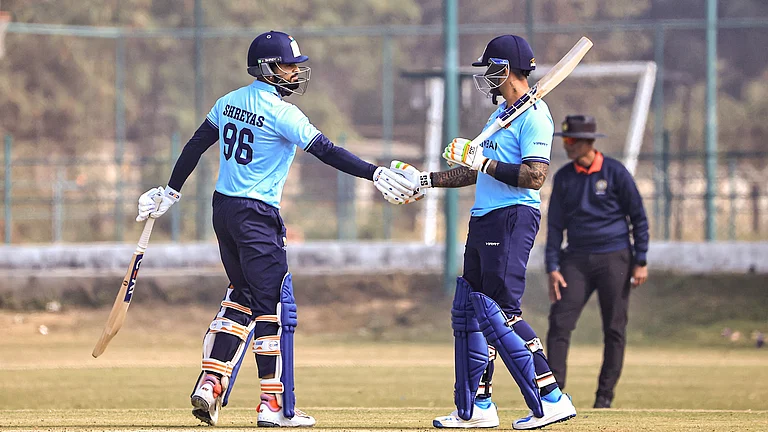Ramayan Shah has a pavement stall selling food on Free School Street in front of a sign that says Sarabhai Chemicals. The building behind him is Karnani Mansions, and the look of the sign suggests superannuation, an office boarded up. Ramayan Shah and two other low-level entrepreneurs—the always-absent owner of Chandan Hotel, which roughly occupies six by six feet on the pavement, and Nagendra, with his heavy iron and board—have appropriated the terrain here.
I can remember a time when these businesses didn’t exist in this location, and one could walk from Park Street up Free School Street without any interruption. At a glance, the stalls are squalid, a small universe of cooking pots, potato peels, benches, and a few people absently lolling under the shelter of tarpaulin. They comprise an island with no apparent connection to the Free School Street of the seventies and early eighties, with its rare second-hand vinyl records and its second-hand bookshops, which even now sell everything from horoscopes to Leon Uris to Salman Rushdie to old copies of Time. In 1982, before leaving for England, suddenly disenchanted by Western popular music, I remember bringing with me from Bombay some of the priceless records in my collection (among them Janis Joplin Live), to either distribute gratis among friends who were still under the spell of that music or permit the more mercantile among them to sell the records to the vendors on Free School Street. One of my friends earned six hundred rupees from the sale (some of these records were rare, bought in a London Our Price shop by my father), a small fortune at the time. I took nothing of the proceeds, a measure of my new high-minded propensities. It was a way of washing my hands, with violent symbolism, of my Western music past. Yet how alive Free School Street was, still busy with transactions between bourgeois and punter, coursing with some of the sensuousness of the seventies! The secondhand bookshops are still there, as are the vendors of the vinyl records, but it isn’t clear who the customers are. There’s more activity in the recent Bangladeshi restaurants, and in the small shady foreign exchange outlets at which Bangladeshi tourists can quickly change takas into rupees.
Just here, not far from Ramayan Shah’s business, is one of the city’s nerve-centres. Downtown is one name for it, I suppose, but that term with its hint of sleaze doesn’t capture the melee of this intersection, where people are forever waiting to cross at the traffic lights. You have Free School Street on one end, Middleton Row, narrower and shorter, on the opposite side, and, at a right angle to these two, Park Street, this long road finally opening out on to the chaos of Park Circus, and, nearer this end, to the once-imperial artery, Chowringhee. Park Street is neither Oxford Street nor the Champs-Élyseés, but here, in the stretch between Chowringhee and the junction of Free School Street and Middleton Row, it has an energy comparable to no other downtown district that I know. Although Calcutta, with its colonial buildings, was so Bengali in its metier, just here it is like nowhere else in the city, for the Chinese and the so-called Anglo-Indians (or Eurasians) used to live on Free School Street, and a few still do, and down Middleton Row are the inaccessible precincts of the Loreto College for Girls, with its calm but admonitory gates. As a child from Bombay, walking up Park Street and approaching this junction, I knew—without quite knowing why—that I’d never, elsewhere, had such contradictory impulses converge around me.
Uniquely placed, over the decades, to at once view and receive these drifts and convergences, is Flurys, at the corner of Park Street and Middleton Row. Flurys is a tea shop. Once created by a Swiss confectioner, it’s now owned by the Apeejay Group, who made their money in tea. If, upon entering, you turn left and occupy one of the tables overlooking the new large glass windows, you can partake of the astonishment of this area, as hordes of pedestrians, with an odd urgency about them, wait, some distance away, to cross to the Free School Street side. You order your coffee and cake, or rissole, and, every five or ten minutes, see the scene repeat itself: the current of passers-by advancing aimlessly, then beginning to congeal at the traffic lights, and finally dispersing, scattering, and temporarily losing form. It seems to you that there are all kinds of people in that crowd visible from the Flurys window—office-goers; wage-earners; youthful groups in jeans; tourists; people who have returned to these parts for tea or coffee; Europeans, in their loose handwoven clothes, with bare white arms showing. They all seem to have arrived from, or to be moving towards, some landmark: New Market, further up, off Free School Street, or one of the half-lit restaurants on either side, or St Xavier’s College, or Chowringhee. When you look up from your cup, you’re struck by this mixture of unpredictability and purpose. I probably first saw Flurys when I was five or six years old. My earliest memory is of going with an older cousin (my aunt’s son) and a cousin around my age (a maternal uncle’s son, in whose house the older cousin was staying as a lodger) to Flurys on a Sunday, and finding its interior humming loudly. The older cousin, a migrant from Assam, was an exceptional student, and was studying for his chartered accountancy while working at Guest Keen Williams. He—despite his meagre means, and perhaps in anticipation of the success he’d one day have—made at least one extravagant gesture a week, which included buying us books or comics; that day, it was a trip to Flurys. I say ‘earliest memory’, but that does not mean it was my first visit; I remember a sense of recognition on entering the place. Certainly, the Bombay I knew had no venue for such focused congregating, where every item on the menu—baked beans on toast, sausage roll, scrambled eggs, pineapple pudding cake, buttered toast—had an idiosyncratic pedigree. That day was the first time I had a chicken croissant—croissant-shaped bread sliced through the middle, buttered, patted with mustard, and filled with shreds of roast chicken. This slyly unprepossessing confection was always a little too expensive to order (when a cousin was taking you out) without embarrassment, and often it was in short supply (a fact conveyed to you by an unrelenting shake of the waiter’s head), maybe because the croissant-shaped bread was produced in small quantities; until, about fifteen years ago, it fell off the menu and disappeared. My memory of its taste is a reminder that, in Calcutta, in a sort of ritual transubstantiation, you were constantly consuming the flesh and blood of urban modernity; that modernity was, at least until the moment I’m thinking of, the city’s bread and butter. The general high spirits (despite the surly waiters) in Flurys that afternoon is also my one memory of a city that still had no inkling of Naxalbari, and the lust for revolution.
With the emergence and then the crushing of the Naxalites, Flurys went quiet in the early seventies—as did Christmas in Park Street. Until, say, 1969, Calcutta had the most effervescent and the loveliest Christmas in India—probably, I’d hazard, based on my experience later of Christmas in England, the loveliest in the world. Warm, convivial, unfolding in smoky weather, it had the vivacity of a transplanted custom that had flowered spontaneously, but still retained the air of an outing, of an encounter with the strange. Its beauty and atmosphere derived not only from the Anglo-Indians, or the last of the English living and working in Calcutta, but also from a certain kind of Bengali who had embraced the festival. I was reminded of this Bengali type when walking through the Jewish Museum in late 2005 in Berlin, a striking building in an area called Hallesches Tör. Our straggly bunch had followed the guide irresistibly until we came, on the first floor, to a rather sparse reconstruction of an educated Jewish household from the twenties with a piano at the centre. On a sort of noticeboard was a newspaper cutting from the time, with a satirical cartoon recording the stages through which a Hanukkah transmogrified into a Christmas tree—clearly meant to poke fun at the new secular Jew. Although I’d been silent so far, I couldn’t help interjecting at this point (the guide encouraged dialogue): ‘This was happening in other parts of the world as well—it was happening in Bengal.’ Two or three people in my group nodded, as if they knew exactly what I meant; and, perhaps, for a moment, they had an intimation that the story of change that had taken place in Europe had also occurred further afield.

| Photograph by Reuters, From Outlook 04 February 2013 |


























